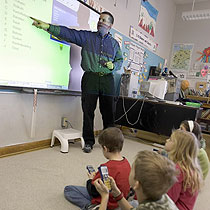When Gregg Brain first considered a career in teaching, he thought he would spend his days where he found so many of his own mentors — in a high school gymnasium.
On a recent morning, Brain prepared for the school year in a very different environment — a classroom filled with coat hooks hung low on the wall and plastic chairs designed for 10-year-olds. Brain, 26, is starting his career not as a high school physical education teacher, but as an elementary educator.
Just 18 per cent of elementary school teachers in Edmonton are men, according to 2006 Statistics Canada data. That’s slightly higher than the national average of 16 per cent.
Theories about why so few men choose to become teachers, particularly at the elementary level, are well-discussed in education circles: the perception that teaching is a “female” profession continues; the pay, especially in the early years, is lower than other fields; the notion that men who choose to work with young children could be viewed as predators persists.
A question that sparks more debate is this: Does having male teachers matter?
For Brain, whose plan of becoming a high school phys-ed teacher was sidetracked after he was accepted into an elementary education program, the answer is not clear.
“It’s not necessarily a sex factor, being a male or a female, it’s about bringing new ideas into the classroom,” he said.
Brain concedes he could bring different perspectives to Lendrum Elementary School, where the overwhelming majority of staff is female. He has already been appointed the school’s track coach.
Some students have already informed Brain he is the first male teacher they have encountered in school.
For years, such experiences weren’t a concern for teachers, parents or administrators.
But schools are under increasing pressure to deliver top marks, placing a spotlight on young boys who have historically performed worse than girls in school, says Janice Wallace, the University of Alberta’s associate dean of undergraduate teacher education. Added to that is a changing economy where high school diplomas are generally required to land full-time employment.
Wallace argues the evidence linking the performance of male students and the presence of male teachers is weak. If anything, a teacher’s race and class — rather than their gender — could more profoundly impact the academic success of male students, she says. Middle-class boys are likely to excel in school, while boys and girls from disadvantaged backgrounds often struggle more.
“There’s been this equation between how boys do in school and having male teachers, and somehow having a male teacher will make boys better learners,” Wallace said. “What they need is really good teachers. And a really good male teacher? Great. A really good female teacher? Great. What we need are really good teachers who are able to engage students at all levels.”
In her research, Wallace found male teachers are often assumed to hold stereotypical masculine traits, such as excelling in sports. Boys who don’t conform to those stereotypes might not connect with a male teacher as much as some might hope.
“It’s not like boys are this big homogeneous category who are going to benefit from men, who are this big homogeneous category. It just doesn’t work as neatly as that,” Wallace said.

